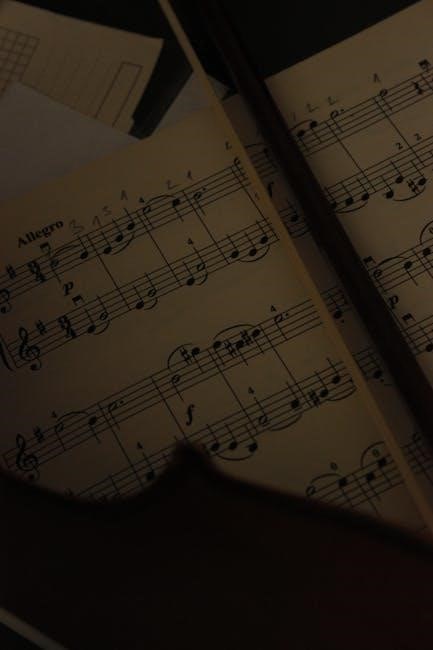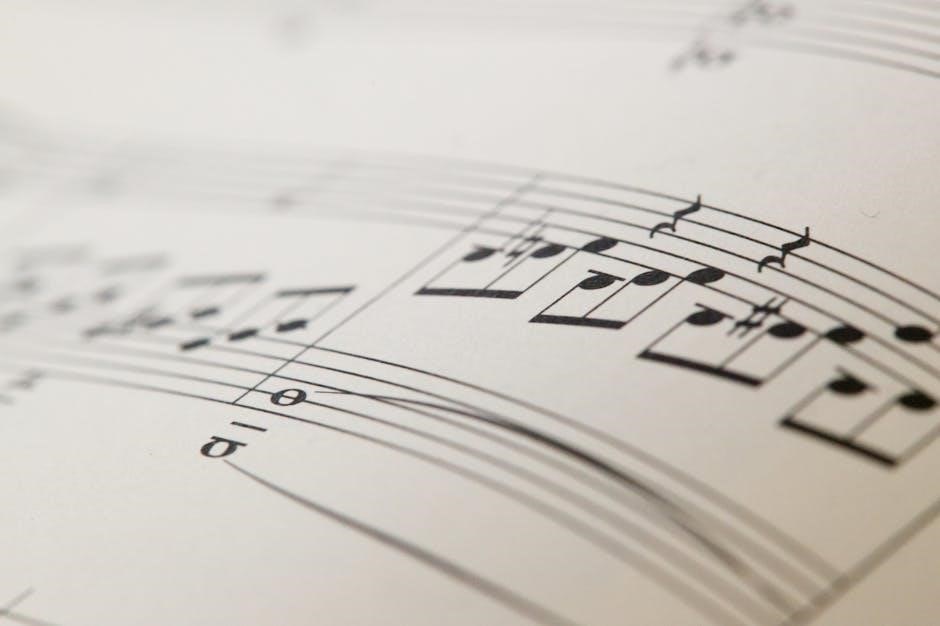moonlight sonata piano sheet music pdf
Summary
Craving that haunting melody? Download your Moonlight Sonata piano sheet music PDF instantly! No signup, just pure Beethoven bliss. Start playing today! ✨

Moonlight Sonata Piano Sheet Music PDF: A Comprehensive Guide
Embark on a musical journey with Beethoven’s iconic Moonlight Sonata! This comprehensive guide helps you find, understand, and play this masterpiece․ Discover resources for downloading sheet music in PDF format․ From easy arrangements to advanced scores, explore the world of Moonlight Sonata!
Beethoven’s Piano Sonata No․ 14, universally known as the Moonlight Sonata, stands as a testament to the composer’s genius․ Officially titled “Sonata quasi una fantasia,” Op․ 27, No․ 2, this piece transcends its mere classification as a sonata, inviting listeners into a realm of profound emotion and captivating melodies․
Composed in 1801 and dedicated to Countess Giulietta Guicciardi, a student of Beethoven’s with whom he was, allegedly, in love, the Moonlight Sonata quickly gained recognition for its innovative structure and deeply expressive character․ The name “Moonlight Sonata” wasn’t coined by Beethoven himself; it originated from a critic’s description of the first movement’s ethereal and dreamlike quality, evoking images of moonlight shimmering across a serene lake․
The sonata comprises three distinct movements, each contributing to the overall narrative․ The first movement, Adagio sostenuto, is characterized by its haunting melody and delicate arpeggios, creating an atmosphere of profound introspection․ The second movement, Allegretto, offers a brief respite with its graceful and lighthearted character․ Finally, the third movement, Presto agitato, explodes with fiery passion and virtuosic display, showcasing the composer’s dynamic range․
Understanding the Popularity of Moonlight Sonata
The enduring popularity of Beethoven’s Moonlight Sonata is a phenomenon rooted in its profound emotional depth, accessibility, and timeless appeal․ Its haunting melody, particularly in the first movement, resonates with listeners across generations, evoking feelings of longing, introspection, and a touch of melancholy․
The sonata’s structure, deviating from traditional sonata form, contributes to its unique allure․ The first movement’s unconventional character, with its sustained chords and delicate arpeggios, creates an atmosphere of dreamlike serenity, captivating audiences from the very first notes․
Furthermore, the Moonlight Sonata’s relative accessibility, at least in its first movement, has made it a favorite among aspiring pianists․ While mastering the entire sonata demands considerable skill, the first movement can be learned and appreciated by those with intermediate piano proficiency․ This accessibility has broadened its audience and cemented its place in popular culture․
The Moonlight Sonata’s influence extends beyond the realm of classical music, appearing in numerous films, television shows, and video games․ Its evocative melodies have been sampled and reinterpreted in various genres, further solidifying its iconic status and ensuring its continued relevance in the 21st century․
Finding Free Moonlight Sonata Sheet Music PDF Online
The quest for free Moonlight Sonata sheet music in PDF format is a common pursuit for many musicians․ Several online resources offer downloadable scores, providing access to this iconic piece without immediate cost․ Websites like IMSLP (International Music Score Library Project) host a vast collection of public domain sheet music, including various editions of the Moonlight Sonata․
Mutopia Project is another valuable resource, offering free sheet music transcriptions created by volunteers․ These scores are often meticulously prepared and readily available for download․ Other websites, such as MuseScore․com, also provide user-submitted arrangements and transcriptions, although the quality may vary․
When searching for free sheet music, it’s essential to exercise caution and verify the accuracy and completeness of the score․ Look for editions that are clearly legible and well-formatted․ Additionally, be mindful of potential copyright restrictions, particularly for more recent arrangements or editions․ While public domain scores are generally free to use, copyrighted material requires permission or a license for legal distribution and performance․
Before downloading, consider previewing the sheet music to ensure it meets your needs and skill level․ Some websites offer sample pages or audio recordings to help you assess the quality of the score․ Always be sure to scan all files to ensure they are virus free․
Legality of Downloading Free Sheet Music
Navigating the legality of downloading free sheet music requires understanding copyright laws․ Generally, musical works are protected by copyright, granting exclusive rights to the composer or publisher․ However, these rights eventually expire, placing the work in the public domain․
Sheet music for pieces in the public domain, like Beethoven’s Moonlight Sonata, is generally free to download and use․ However, arrangements or editions created more recently may still be under copyright․ It’s crucial to distinguish between the original composition and any new arrangements․
Downloading copyrighted sheet music without permission is considered infringement․ Websites offering such downloads may be operating illegally, and users could face legal repercussions․ To avoid copyright issues, stick to reputable sources like IMSLP or Mutopia Project, which primarily offer public domain scores․
Always check the copyright information associated with the sheet music before downloading․ If the work is copyrighted, seek permission from the copyright holder or purchase a legitimate copy․ Supporting composers and publishers ensures the continued creation and availability of musical resources․ By respecting copyright laws, you contribute to a fair and sustainable music ecosystem and avoid legal issues․
Different Arrangements of Moonlight Sonata Sheet Music
Moonlight Sonata, originally composed for solo piano, has inspired countless arrangements for various instruments and skill levels․ These arrangements cater to diverse musical tastes and abilities, expanding the reach of Beethoven’s masterpiece․ From simplified versions for beginner pianists to complex orchestrations, the possibilities are endless․
One common arrangement is for solo violin, capturing the melody’s haunting beauty․ Guitar arrangements, both classical and fingerstyle, also exist, offering a different tonal palette․ Vocal arrangements, with added lyrics, transform the sonata into a poignant song․ Ensembles, such as string quartets or chamber orchestras, often perform arrangements that highlight the piece’s harmonic richness․
Furthermore, simplified piano arrangements are available for beginners, focusing on the essential melody and harmonies while omitting complex passages․ These arrangements provide an accessible entry point to the sonata․ More advanced arrangements may incorporate improvisational elements or explore different harmonic interpretations․
When choosing an arrangement, consider your instrument, skill level, and desired musical experience․ Explore different options to find one that resonates with you․ Whether you’re a seasoned musician or a beginner, there’s an arrangement of Moonlight Sonata to suit your needs․ Embrace the versatility of this timeless piece and discover its beauty in various forms․
Easy Piano Arrangements for Beginners
For aspiring pianists eager to tackle Beethoven’s Moonlight Sonata, simplified arrangements provide an accessible entry point․ These easy piano versions retain the essence of the first movement’s haunting melody and harmonic structure while reducing technical demands․ They are ideal for beginners with limited experience․
These arrangements often feature simplified harmonies, using basic chords and voicings․ Complex passages are omitted or modified, focusing on the core melody․ The tempo may be slightly slower, allowing beginners to grasp the rhythm and phrasing․ Fingering suggestions are usually included, guiding students through the piece․ These adaptations make learning more manageable, fostering confidence and enjoyment․
Easy piano arrangements typically prioritize the melody in the right hand, supported by simple chords in the left․ The original’s intricate arpeggios may be replaced with block chords or simplified patterns․ The overall length might be shortened, focusing on the most recognizable sections․
These simplified versions serve as a stepping stone towards the full sonata․ As beginners progress, they can gradually incorporate more challenging elements․ Starting with an easy arrangement allows students to develop their skills and appreciation for this timeless masterpiece․ It provides a rewarding musical experience without overwhelming them with technical complexities․ Embrace the beauty of Moonlight Sonata, regardless of your skill level!
Advanced Piano Arrangements for Experienced Players
For seasoned pianists seeking a deeper engagement with Beethoven’s Moonlight Sonata, advanced arrangements offer a challenging and rewarding experience․ These versions often go beyond the standard score, incorporating intricate embellishments, alternative harmonies, and virtuosic passages․
Advanced arrangements may explore the piece’s emotional depth through nuanced interpretations․ They might include detailed performance notes, suggesting specific articulations, dynamics, and pedaling techniques․ These annotations guide experienced players in crafting a compelling and expressive rendition․
These arrangements might also feature transcriptions of the other movements, allowing pianists to perform a complete sonata․ They might integrate elements from orchestral versions, creating a richer and more complex soundscape․ Advanced players often use these arrangements to showcase their technical prowess and musicality․
Furthermore, some advanced arrangements incorporate improvisational elements․ They might provide a framework for pianists to create their own variations and cadenzas․ This allows for a personal and unique interpretation of the piece․ These arrangements demand a high level of technical skill, musical understanding, and artistic creativity․

Ultimately, advanced arrangements of Moonlight Sonata cater to experienced players who seek to push their boundaries and explore the piece’s full potential․ They offer a platform for showcasing virtuosity, musicality, and individual expression․ These arrangements inspire a deeper appreciation for Beethoven’s genius and the enduring power of this iconic sonata․
Analyzing the First Movement (Adagio Sostenuto)
The first movement of Beethoven’s Moonlight Sonata, marked Adagio Sostenuto, is renowned for its melancholic beauty and ethereal atmosphere․ Its structure, characterized by a modified sonata form, unfolds with a delicate simplicity that belies its emotional depth․
The movement primarily resides in C-sharp minor, a key that contributes to its somber and introspective character․ The melody, a haunting and lyrical line, unfolds gradually over a gently pulsating accompaniment․ This accompaniment, often described as resembling a funeral march, creates a sense of quiet sorrow․
The dynamic range of the movement is generally subdued, with a focus on pianissimo and mezzo-piano․ This contributes to the intimate and contemplative mood․ However, subtle crescendos and diminuendos add shape and expression to the musical phrases․
Harmonically, the movement is rich and nuanced, with unexpected chord changes and dissonances that heighten the emotional tension․ The use of arpeggios and broken chords creates a sense of fluidity and movement․ The overall effect is one of profound beauty and quiet resignation․
Analyzing the first movement reveals Beethoven’s masterful use of melody, harmony, and dynamics to create a deeply moving and unforgettable musical experience․ Its enduring popularity stems from its ability to evoke a wide range of emotions, from sorrow and longing to hope and serenity․ Its structure offers a blend of simplicity and complexity․
Key Signatures and Time Signatures in the Sheet Music
Understanding the key and time signatures is crucial for accurately interpreting and performing Moonlight Sonata from sheet music․ The first movement (Adagio Sostenuto) is primarily in C-sharp minor․ This key signature features four sharps: F#, C#, G#, and D#․ Recognizing this immediately sets the somber and introspective tone of the piece․
While the main key is C-sharp minor, the music modulates to other related keys, such as E major (the relative major of C-sharp minor) and G-sharp minor (the dominant minor), adding harmonic interest and variety․ Be aware of these key changes within the score․
The time signature for the first movement is 4/4, indicating four beats per measure․ The slow tempo marking (Adagio Sostenuto) dictates that each beat should be performed slowly and deliberately, contributing to the movement’s melancholic character․ The time signature remains consistent throughout the movement, providing a stable rhythmic framework for the flowing melody․
Later movements explore different key signatures․ The second movement (Allegretto) is in D-flat major (enharmonic equivalent of C-sharp major), with five flats in the key signature: Bb, Eb, Ab, Db, and Gb․ The third movement (Presto Agitato) returns to a minor key, often interpreted as G-sharp minor or C-sharp minor depending on the edition․ The time signature is 4/4, but its fast tempo and agitated character create a stark contrast to the first movement․
Dynamics and Articulation Markings to Observe

Paying close attention to dynamics and articulation is paramount for an expressive performance of Moonlight Sonata․ The first movement, marked Adagio Sostenuto, relies heavily on subtle dynamic nuances․ The opening measures are typically marked “pianissimo” (pp), indicating a very soft volume․ Gradual crescendos and diminuendos are essential for creating a sense of ebb and flow, building tension and releasing it effectively․
Observe markings like “crescendo poco a poco” (gradually increasing volume) and “diminuendo” (decreasing volume)․ These markings guide the emotional trajectory of the music․ The use of the pedal is crucial in sustaining the harmonies and creating a resonant sound, but avoid over-pedaling, which can muddy the clarity of the piece․ Pay attention to specific pedal markings in the sheet music․
Articulation markings, such as legato (smooth and connected) and staccato (short and detached), contribute to the musical phrasing․ The first movement primarily uses legato, emphasizing the sustained and lyrical quality of the melody․ The second movement, Allegretto, features a lighter touch, with more detached notes and playful phrasing․
The third movement, Presto Agitato, demands a wide dynamic range and precise articulation․ Sudden changes in volume and rapid passages require careful attention to detail․ The contrasting dynamics and articulation contribute to the movement’s dramatic and virtuosic character․ Mastering these aspects elevates the performance․
Tips for Learning and Practicing Moonlight Sonata
Learning Moonlight Sonata requires patience and a strategic approach․ Begin by thoroughly familiarizing yourself with the score․ Analyze the structure, key signatures, and time signatures․ Understand the harmonic progression and melodic contours of each movement․
Start with slow practice․ Focus on accuracy and evenness of tone․ Gradually increase the tempo as you become more comfortable․ Practice small sections at a time, mastering each before moving on․ Use a metronome to maintain a steady beat․ Pay attention to the fingering suggestions in the sheet music․
Listen to recordings of professional pianists performing Moonlight Sonata․ This will help you develop an understanding of the musical interpretation and phrasing․ Experiment with different interpretations to find what resonates with you․
For the first movement, focus on creating a calm and serene atmosphere․ Maintain a consistent tempo and avoid rushing․ Pay attention to the subtle dynamic nuances․ Use the pedal sparingly to create a sustained and resonant sound․
The second movement requires a lighter touch․ Practice the detached notes and playful phrasing․ Maintain a steady tempo and avoid over-pedaling․ The third movement demands technical proficiency and stamina․ Practice the rapid passages slowly and gradually increase the tempo․ Focus on maintaining accuracy and clarity․

Regular practice is essential for mastering Moonlight Sonata․ Set realistic goals and celebrate your progress along the way․
Recommended Editions of Moonlight Sonata Sheet Music
Selecting the right edition of Moonlight Sonata sheet music is crucial for an accurate and fulfilling learning experience․ Several reputable publishers offer editions that cater to various skill levels and preferences․
For a reliable and scholarly edition, consider Henle Verlag․ Their editions are known for their accuracy and attention to detail, based on thorough research of original manuscripts․ Wiener Urtext Edition is another excellent choice, providing a clean and uncluttered score with helpful annotations․
Alfred Music offers editions that are well-suited for students․ These editions often include helpful fingering suggestions, performance notes, and historical background information․ Schirmer Performance Editions are also popular among students, providing a combination of accuracy and accessibility․
For those seeking a more visually appealing edition, consider editions from Bärenreiter or Breitkopf & Härtel․ These editions often feature high-quality printing and elegant layouts․
When choosing an edition, consider your skill level and learning style․ Beginners may prefer editions with simplified arrangements or additional guidance․ Advanced players may prefer editions that offer more interpretive freedom․
It’s also worth checking online retailers and libraries for digital editions of Moonlight Sonata sheet music․ These editions can be convenient and affordable, but be sure to verify the accuracy and quality before purchasing or downloading․
Ultimately, the best edition is the one that best suits your individual needs and preferences․ Take the time to explore different options and find the edition that will help you bring Moonlight Sonata to life․
The Moonlight Sonata, a cornerstone of piano repertoire, offers a profound musical experience for both performer and listener․ Its enduring appeal lies in its emotional depth, technical challenges, and historical significance․ Appreciating this masterpiece involves understanding its context, structure, and interpretive possibilities․
Performing the Moonlight Sonata is a rewarding journey that requires dedication and patience․ Mastering the technical aspects, such as the delicate arpeggios in the first movement and the fiery passages in the third, demands consistent practice and attention to detail․
Beyond technical proficiency, interpreting the Moonlight Sonata requires a deep understanding of its emotional landscape․ The first movement, with its melancholic beauty, calls for a sensitive and expressive touch․ The second movement, a brief respite, offers a moment of lightness and grace․ The third movement, a tempestuous outburst, demands passion and intensity․
Ultimately, performing the Moonlight Sonata is about connecting with the music on a personal level․ By studying the score, listening to recordings, and exploring different interpretations, you can develop your own unique understanding of this iconic work․

Whether you are a seasoned pianist or a beginner, the Moonlight Sonata offers a wealth of musical riches to discover․ Embrace the challenge, explore the possibilities, and allow yourself to be transported by the beauty and power of Beethoven’s masterpiece․ Its timeless melodies and profound emotions will resonate with you long after the final note has faded․